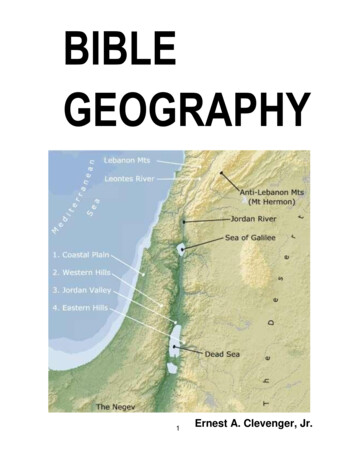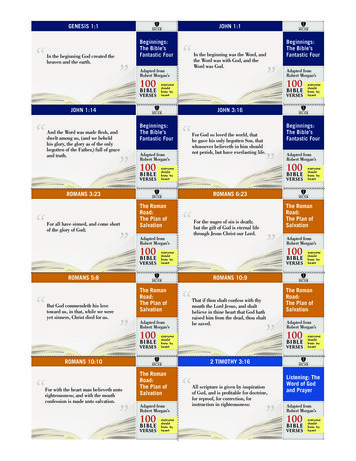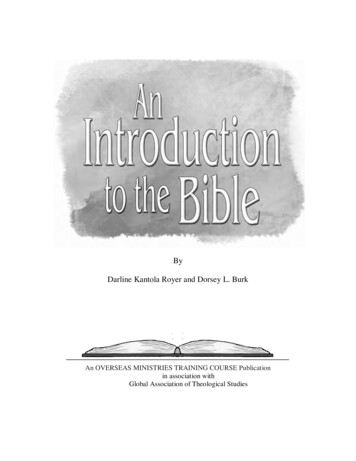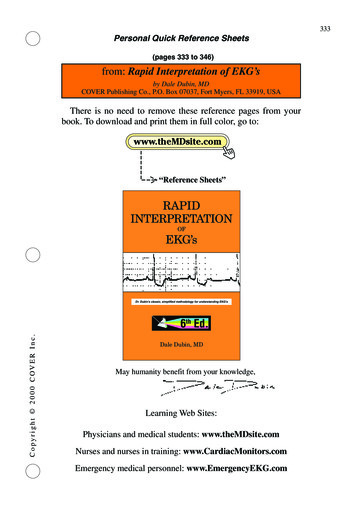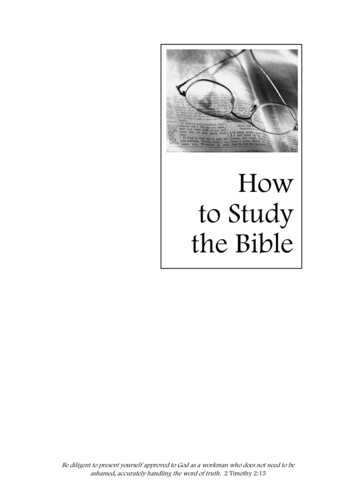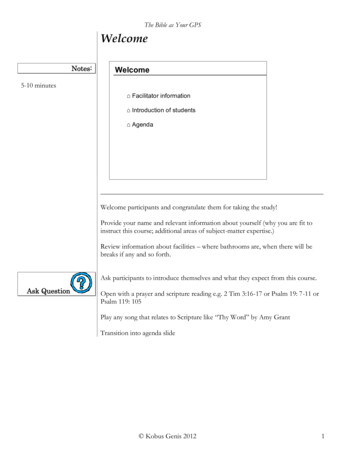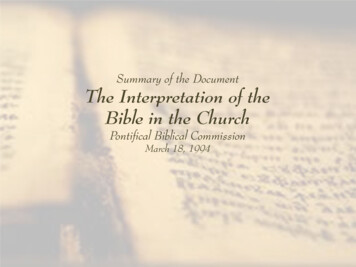
Transcription
Summary of the DocumentThe Interpretation of theBible in the ChurchPontifical Biblical CommissionMarch 18, 1994
Made bySr. Grace Marie Heinrich, SCTJMServants of the Pierced Hearts of Jesus and Mary
Preface and Introduction The purpose of the document– To “inquire into how the meaning of Scripture mightbecome known” by giving a “well-grounded overview of the present-day methods and offers an orientation to thepossibilities and limits of these approaches” Relevant Magisterial documents– Providentissimus Deus – Pope Leo XIII (1893)– Divino Afflante Spiritu – Pope Pius XII (1943)– Dei Verbum – Second Vatican Council (1965)
Preface and Introduction The rise of new methods of Scriptural interpretation,including the “historical-critical method” brings“hidden dangers along with its positive possibilities” Dei Verbum of the II Vatican Council presents a“synthesis between the lasting insights of patristictheology and the new methodological understandingof the moderns”
Preface and Introduction The historical-critical method– This method is “attentive to the historical development oftexts or traditions across the passage of time” (diachronicapproach) and is a more ‘scientific’ approach to Scripturalstudy– Has the possibility that “only the human dimension of theword appears as real, while the genuine author, God isremoved from the reach of a method which was establishedfor understanding human reality.”– Also criticized for taking the understanding of Scripture outof reach of the faithful and putting it exclusively into thehands of scholars
Methods and Approaches for Interpretation:The Historical- Critical Method The “proper understanding [of Scripture] not onlyadmits to the use of this method but actually requiresit” Through the process outlined in the historical-criticalmethod “it is possible to understand far moreaccurately the intention of the authors and editors ofthe Bible as well as the message”
Methods and Approaches for Interpretation:The Historical- Critical Method This method was used, in “much less developed” forms, bySt. Jerome, St. Augustine, and Origen Entails four main stages– Textual criticism – examines manuscripts to find a text “as closeas possible to the original”– Literary criticism - “dissecting” the text in the “quest forsources”– Critical study of forms - identifying the genre – eg. Hymn orlegend– Redaction criticism -the “critical study of the process of editing”which is “attentive to the text as it has been put together” andallows for a “better grasp of the content of divine revelation”because the text “is explained as it stands”
Methods and Approaches for Interpretation:The Historical- Critical Method It is a historical method because it sheds light onhistoric processes which took time and were complexas well as which audience the writing was directed toand their historical context It is scientific in that it uses “criteria that seek to be asobjective as possible” It is analytical in that it studies “biblical text in the samefashion as it would study any other ancient text”
Methods and Approaches for Interpretation:The Historical- Critical Method Evaluation– “Once the method was freed from external prejudices, it led to amore precise understanding of the truth of sacred Scripture (cf.“Dei Verbum,” 12)– “According to ‘Divino Afflante Spiritu,’ the search for the literalsense of Scripture is an essential task of exegesis and, in order tofulfill this task, it is necessary to determine the literary genre oftexts”– There is a necessity to include a “synchronic analysis” (looking atthe text as a whole for what it is in its “final stage”) because it isthis stage “which is the expression of the word of God”– Yet diachronic study makes known the “historical dynamismwhich animates Scripture and sheds light on its rich complexity.”
Methods and Approaches for Interpretation:Rhetorical Analysis “Rhetoric is the art of composing discourse aimed atpersuasion” 3 approaches– Classical Greco-Roman Investigates the authority of the speaker, the force of theargument in the discourse, and the feelings aroused in theaudience in three different modes (judicial, deliberative anddemonstrative)– Semitic Looks at parallels in symmetrical compositions– “New Rhetoric” “investigates what makes a particular use of language effective andsuccessful in the communication of conviction” and penetrates “tothe very core of the language of revelation” Important to “rediscover or clarify original perspectives that hadbeen lost or obscured”
Methods and Approaches for Interpretation:Rhetorical Analysis Limitations– Can remain at simply a level of description and thus reflects“a concern for style only”– As a synchronic method, it cannot stand alone as a methodof interpreting Scripture – it should be used with adiachronic method.
Methods and Approaches for Interpretation:Narrative Analysis This method “studies how a text tells a story in such a way asto engage the reader in its “narrative world” and the system ofvalues contained in them Many distinguish between the actual and implied authors andreaders (the actual writer and the writer whose image isconveyed in the text and the reader the author was writing forand the reader of today) – the impact of the narrative is linkedwith the actual reader being able to identify with the impliedreader Sees the text as a “mirror” in which a certain image isprojected (as opposed to the historical-critical method whichsees the text as a “window”)
Methods and Approaches for Interpretation:Narrative Analysis This method is very useful in “facilitating thetransition from the meaning of the text in itshistorical context to its significance for the reader oftoday” Limitations– Synchronic approach that needs to be supplemented bydiachronic methods– Cannot exclude doctrinal sources that have commentedabout the texts being analyzed– The recognition that the poignancy of a particular passagedoes not necessarily mean that “its full truth has beenadequately grasped”
Methods and Approaches for Interpretation:Semiotic Analysis (Structuralism) 3 Main Principles– Principle of immanence: “text forms a unit of meaning complete initself it does not look to any date ‘external’ to the text”– Principle of the structure of meaning: “There is no meaning givenexcept in and through relationship.”– Principle of the grammar of the text: “Each text follows a certainnumber of rules or structures” 3 Levels of Analysis– Narrative: Looks at ‘phases’ which “mark the transformation fromone state to another” and at the roles of ‘actants’ in the narrative– Level of Discourse: looks at the “elements of meaning”, tracks thecourse of each figure, and looks at the thematic value of the figures– Logico-Semantic Level: seeks to identify the “logic and meaning[that] underlie the narrative
Methods and Approaches for Interpretation:Semiotic Analysis (Structuralism) Advantages– Helps people come to a better “understanding of the Bible asword of God expressed in human language”– Can be useful in giving “Christians a taste for studying thebiblical text and discovering certain of its dimensions” andcan be used in pastoral practice Limitations– Problematic when some assumptions are made (like the“refusal to accept individual personal identity”)– “Must be open to history”– Often uses “remote and complex language”
Methods and Approaches for Interpretation:Canonical Approach “Reacts against placing an exaggerated value upon what issupposed to be original and early, as if this alone were authentic” It begins from the context of the Bible as a whole and seeks tocomplete the historical-critical method 2 perspectives: working from the final canonical form and fromthe “canonical process” (how the canon came to be) Limitations– Defining the canonical process– Being faithful to the historic context of the Old Testament which appearsin different forms in Jewish Tradition and Church Tradition while at thesame time placing it in the light of the Paschal Mystery
Methods and Approaches for Interpretation:Recourse to Jewish Traditions of Interpretation 2 Fundamental Principles– “A Text only becomes a literary work insofar as it encountersreaders who give life to it by appropriating it to themselves– “This appropriation of the text, which can occur either on theindividual or community level contributes to a betterunderstanding of the text itself.” “Assesses the development of interpretation over the course oftime under the influence of the concerns readers have broughtto the text.” Limitations– Some interpretations have proved to be “tendentious and false”which shows that this approach cannot be autonomous– Emphasis cannot be placed on one historical period over another
Methods and Approaches for Interpretation:Sociological Approach “This approach “has become an integral part ofexegesis” The sociological approach helps “us understand theeconomic, cultural and religious functioning of thebiblical world” and is “indispensable for historicalcriticism” Limitations– Difficult to apply sociological methods to far distant past– Often “pays more attention to the economic and institutionalaspects of human life than to its personal and religiousdimensions”
Methods and Approaches for Interpretation:Approach through Cultural Anthropology Very similar to sociological approach but focuses moreon language, art, and religion rather than institutionsand economics – it looks at “the characteristics ofdifferent kinds of human beings in their social context” Helps us recognize “elements of the biblical messagethat are permanent, as having their foundation inhuman nature, and those which are more contingent,being due to the particular features of certain cultures.” Again, this approach cannot be autonomous
Methods and Approaches for Interpretation:Psychological and Psychoanalytical Approaches Through psychology and psychoanalysis “the texts ofthe Bible can be better understood in terms ofexperience of life and norms of behavior” and bring a“multidimensional understanding of Scripture and helpdecode the human language of revelation.” Specifically, these disciplines can help explain themeaning of “cultic ritual, sacrifice, bans, and imagery” However, it should be cautioned that they noteliminate the reality of sin and salvation
Methods and Approaches for Interpretation:Liberationalist Approach Has no particular methodology but begins from its politicalperspective and is “oriented to the needs of the people” Main principles:– God is the God of the poor and cannot tolerate oppression– Exegesis cannot be neutral but must take sides on behalf of thepoor to liberate the oppressed– “Biblical texts are read in a context of solidarity with theoppressed” Values: awareness of God’s presence, communal faith;liberating praxis based in justice and love Risks: limited scope, one-sided, oversteps into politicalaction, often tied with materialist doctrines and Marxistprinciples
Methods and Approaches for Interpretation:Feminist Approach Several feminist “hermeneutics” have the same goal:“the liberation of women and the acquisition on theirpart of rights equal to those of men.” 3 forms– Radical form – denies all authority of Bible since it was produced by men– “Neo-orthodox” – sees Bible as potentially of service and prophetic as faras it takes the side of women– “Critical” form – rediscover the status and role of women in the life ofJesus and early Church Helps to detect the presence and significance of womenin Scripture, and to “unmask and correct” certain faultyinterpretations that justified male domination
Methods and Approaches for Interpretation:Fundamentalist Approach Holds that the Bible “should be read and interpretedliterally in all its details” Problems: refusal to take historical context of biblicalrevelation into account; undue stress on inerrancy ofcertain details; ignoring problems presented in originallanguages; does not take into account the developmentof Gospel tradition; narrow point of view; anti-Church;private interpretation
Hermeneutical Questions A basic framework is necessary that “allows for theincorporation of the methods of literary and historicalcriticism within a broader model of interpretation.” There must be an interpretation that “expresses thereality of faith but also seeks to link this reality to theexperience of faith in our present world.” “An authentic interpretation of Scripture, then,involves a welcoming of the meaning that is given inthe events and, in a supreme way, in the person ofJesus Christ.”
Hermeneutical Questions The Meaning of Inspired Scripture– Texts are typically identified with 2 senses: literal andspiritual Literal sense – “that which has been expressed directlyby the inspired human authors” Spiritual sense – “the meaning expressed by the biblicaltexts when read under the influence of the Holy Spirit”– Needs to be founded upon the literal sense Fuller sense – “a deeper meaning of the text, intendedby God but not clearly expressed by the human author.”
Characteristics of Catholic Interpretation Catholic exegesis “makes use of the scientific methodsand approaches which allow a better grasp of themeaning of texts.” It is placed “within the living tradition of the church,whose first concern is fidelity to the revelation attestedby the Bible. Runs the risk of “attributing to biblical texts a meaningthey do not contain but which is the product of a laterdevelopment within the tradition.
Characteristics of Catholic Interpretation The formation of the canon was a long process but theChurch “was also discerning and defining her ownidentity.” All members of the Church have role of interpretingScripture – they must “assist the faithful to understandand discern what the word of God is saying to them.”
Characteristics of Catholic Interpretation The task of the exegete– Must pay attention to “historical – critical method”– In carrying out their task, exegetes help others “arrive at thetrue goal of their work.”– Exegetes should also “explain the Christological, canonical,and ecclesial meanings of the biblical texts”– Creates ”a more lively and precise awareness of thehistorical character of biblical inspiration”– Helps theologians avoid dualism and fundamentalism– Publications are important, especially for those who are ableto popularize their exegesis and make it available for the laity
Interpretation of the Biblein the Life of the Church Bringing the Scriptures to “the contemporary situationof the people of God”– “Go beyond the historical conditioning so as to determinethe essential points of the message– Tradition both protects the truth from deviation and“ensures the transmission of the original dynamism”– Methods Hear the word from one’s concrete situation Identify aspects of the present situation highlighted by text Draw from the fullness of meaning of the biblical text
Interpretation of the Biblein the Life of the Church Inculturation brings the Word, not only to today’ssociety (actualization) but to the diversity of cultures Keeping the word at the heart of the Liturgy isessential– The Eucharistic Celebration “brings about the most perfectactualization of the biblical texts written text thus becomesliving word.” Lectio divina, praying with the Scriptures on anindividual or communal level – “prayer shouldaccompany the reading of Scripture”
Interpretation of the Biblein the Life of the Church Scripture in Pastoral Ministry– 3 main situations Catechesis– “Should proceed from the historical context of divine revelationso as to present in the light of God’s overall plan.”– Should be done to facilitate encounter with Christ Preaching– “It is fitting to explain the central contribution of texts, thatwhich is most enlightening for faith and most stimulating for theprogress of the Christian life” Biblical apostolate– “has as its objective to make known the Bible as the word of Godand source of life”– Always presenting the Word with the “respect it deserves”
criticism within a broader model of interpretation." There must be an interpretation that "expresses the reality of faith but also seeks to link this reality to the experience of faith in our present world." "An authentic interpretation of Scripture, then, involves a welcoming of the meaning that is given in


